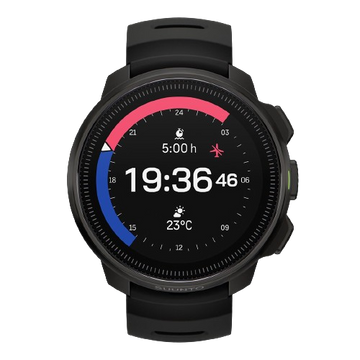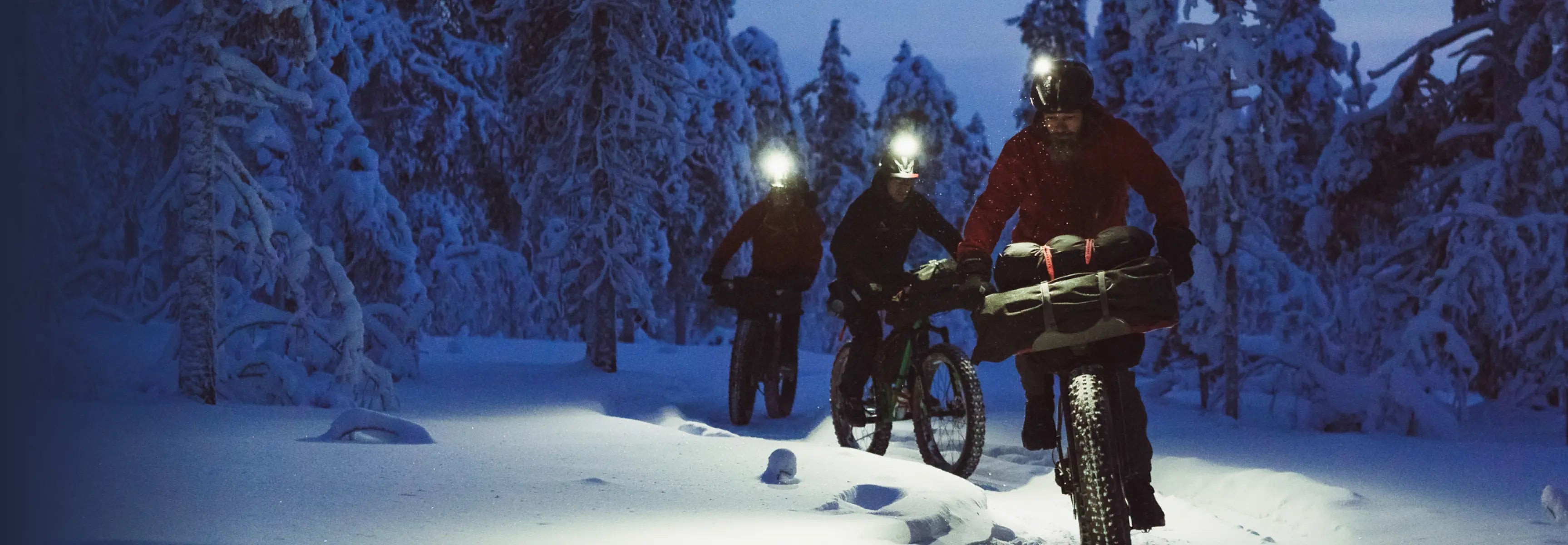
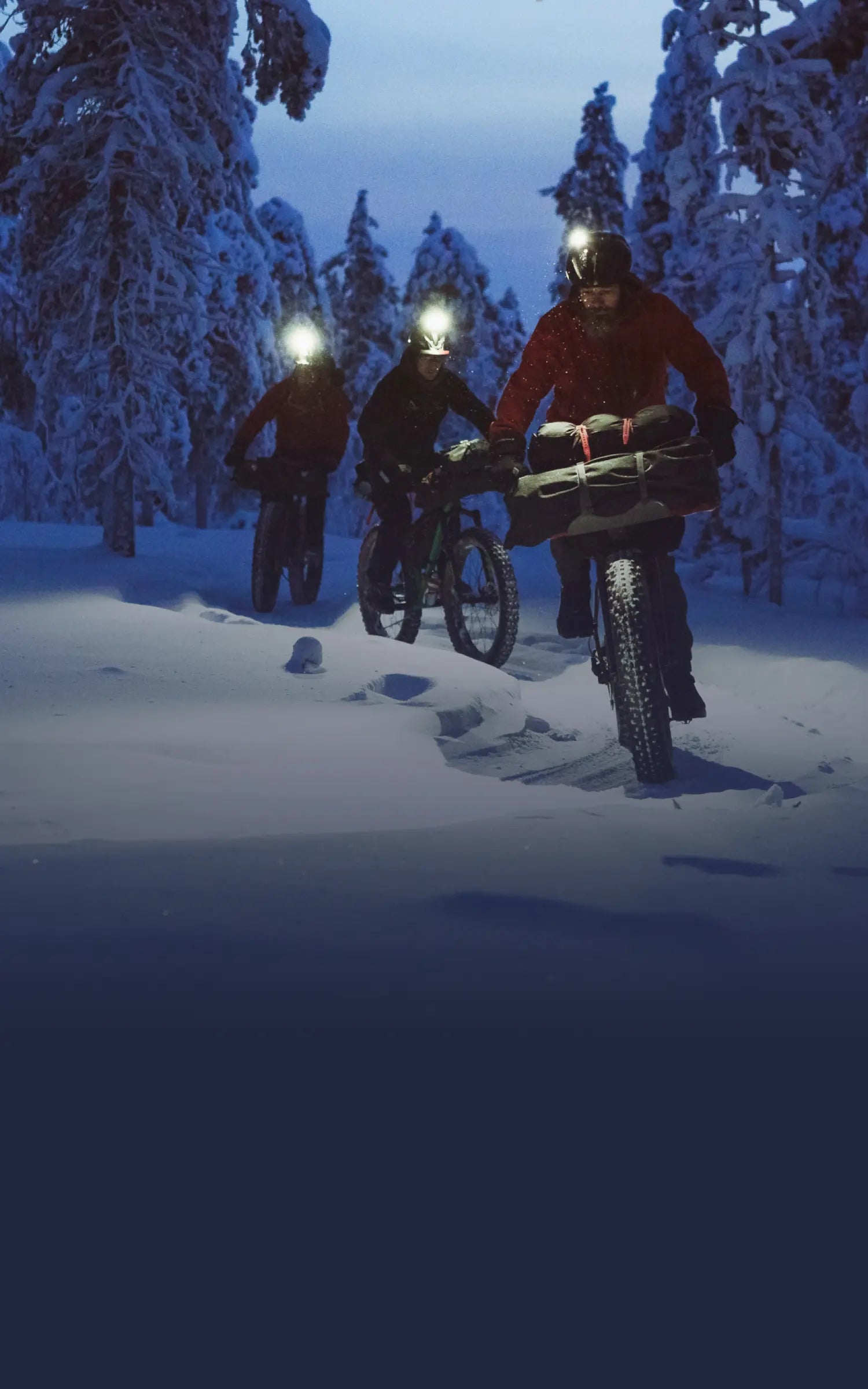
Suunto Blog
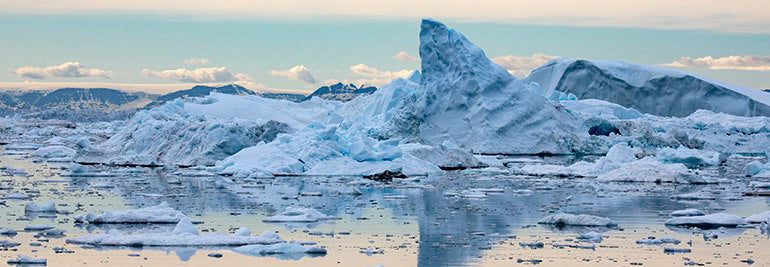
Under thin ice: Jill Heinerth captures climate change
Part of being an explorer is being away from home for long stretches. “Some people say that the two greatest times in the life of an explorer are leaving home and coming home,” Suunto ambassador Jill Heinerth says. “We will each feel loneliness and perhaps regret about moments away from those we love.”
“We feel an overwhelming imperative to document and share,” Jill Heinerth says.
But there are important reasons, sometimes for the greater good, that compel Heinerth and her peers to explore the ends, and depths of the planet. “We feel an overwhelming imperative to document and share,” she says. “When we have a chance to do really good work, telling important stories for humanity, then we are at the top of our game. Adventure fuels our souls.”
Telling an important story for humanity is behind Heinerth recently spending months in Greenland and the Canadian north. She has been on three expeditions to the Arctic to capture footage for an upcoming documentary film about the effects of climate change, called Under Thin Ice. She says the loss of sea ice is changing everything.
“The Arctic is warming faster than any other place on earth, so the changes are quite remarkable, even from year to year,” Heinerth says. “We learn from indigenous people that there are many new things they must adapt to. The sea ice disappears earlier each year. The multi-year ice is lessening and the migrations of fish and mammals are changing with the warming temperatures.
“Atlantic cod move further north into the territory of Arctic cod, competing for food. Bowhead and humpback whales are now seen in the same place at the same time. They used to arrive at different times, spread out by a couple of weeks. If everyone arrives at the buffet at the same time will they wipe out the food stocks? We know for sure that everything is changing.”
The sea ice disappears earlier each year.
Human-caused climate change is also impacting dive conditions, making it more challenging for Heinerth to do her job. “The bay in Ilulissat was filled with smaller bergs than normal, but it was choked with rapidly melting ice,” she says. “The freshwater mixes with seawater, creating a halocline that is difficult to focus through.”
“The melting ice also fizzes, filling the water with tiny bubbles. At times, we were in magically beautiful ice environments that were difficult to film. Warmer ocean temperatures also spawn more green algae that affects visibility.”
"It can take weeks or months of waiting to get the single opportunity for a great shot.”
“Any time you film marine mammals, there is a challenge of first finding them and then finding good and safe conditions for filming them. It can take weeks or months of waiting to get the single opportunity for a great shot.”
Heinerth, however, encountered more than enough wildlife for the documentary. On one day she got particularly lucky. Here is a passage from her journal on lucky day seven of her expedition to Nunavut, Canada’s northernmost territory:
Yesterday’s impossibly dangerous mess of jumbled ice is today’s floe edge, where ice meets the ocean. We are able to walk right to the margin and peer down into the black water. It is alive with narwhals and belugas. I spot a rare bowhead whale and we run for the cameras to try to capture the sight. The sounds are intense. Deep breathing and forced exhalations fill the air with moist spouts from dozens of blowholes. I can see narwhal intermingling with belugas and can hear the canary chirps of the white whales. Groups of seven or eight are huddled together on the surface talking and breathing up to prepare for a dive under the ice which appears to be about four to six feet thick.
Follow Jill Heinerth’s adventures on IntoThePlanet.com. And visit the official Facebook page for more information about the documentary Under Thin Ice.
GET BEHIND THE SCENES OF FILMING "UNDER THIN ICE"
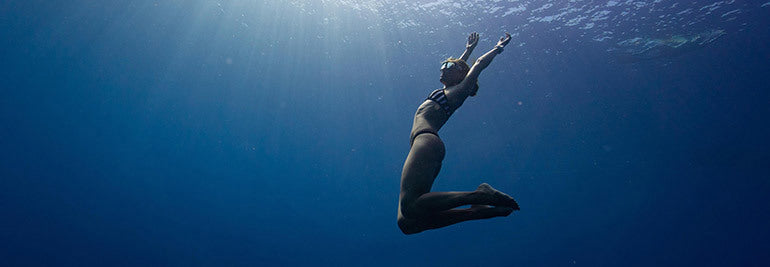
4 reasons rock climbers should learn freediving
© Mike Board
When an earthquake struck Indonesia in August, Kate Middleton’s home on the island Gili Trawangan (neighbouring Bali) was shaken, but not destroyed. “We were lucky to have very little damage, just a couple of walls in the yoga hall,” she says.
The 30-year-old Canadian-New Zealander owns a yoga studio, freediving school and organic cafe on the island. It’s in the clear waters, teeming with exotic marine life, around the island that Middleton trains as a competitive freediver.
Click here to donate to the Lombok Earthquake Support effort underway.
She wasn’t on Gili when the earthquake struck; she was thousands of kilometers away on a different island: Greece’s rock climbing mecca Kalymnous, in the southeastern Aegean sea.
“In 2015, I gifted myself a trip here to learn to rock climb,” the gold medalist says. “I did a beginners and intermediate course back to back, and was totally hooked. The following summer I returned and stayed for two months, climbing almost every day. Now I’m back again.”
© Kalyja Rain
Beginner’s mind
Currently working on climbing a grade 6c route, Middleton is focused on cultivating presence on her climbs, rather than being concerned about numbers and statistics. Competition freediving demands, structured, disciplined training, and what she calls a “monofocus”.
“What I love about both trail running and rock climbing is it’s really easy for me to maintain a ‘beginners mind’ with them,” Middleton says.
Here are her four reasons rock climbers should learn freediving
© Kate Middleton
1. Relaxing into it
The biggest challenge for people new to freediving is learning to relax. “Most of us know how to push and force our way into things, instead of knowing how to relax into our power,” Middleton says. In freediving, relaxation is key for being able to dive deeply on a single breath. Relaxation calms the breath and reduces the heart rate, which conserves oxygen. Tension, stress, force increase the heart rate, wasting energy and oxygen.
“I see where that crosses over into climbing,” she says. “I’ve seen my friends practically float up 50 m overhangs, and I feel they are relaxing into their ability, rather than forcing it. I also see a lot of climbers who climb in a different way, that is more aggressive, and that doesn’t seem to be as efficient or enjoyable.”
Click here to read more about Middelton’s yoga and freediving journey.
2. Breathing well
“Freediving gives you a really great awareness of your breathing and breathing patterns,” Middleton says. “Any time the breath is getting out of balance, maybe due to stress, it’s very easy to pick up on that. This has helped me a lot when I’m climbing. I notice when I’m in the crux of a climb, or when fear starts to edge in, and I start to hold my breath. I then take some deeper breaths, with a steadier rhythm, and then I come back to presence and can continue climbing.”
3. Mastering fear
“Freediving has given me such a sensitivity to what’s happening with me. Because relaxation is so critical for freediving, especial deep diving, I can see so clearly how fear manifests in the body and how tension escalates. If I can catch it early, then it’s a lot easier to regulate and work with.”
4. Finding your power
When most people hear about freediving it seems a little mad, dangerous, even suicidal. But in actual fact, learned properly, it is a safe sport that shows us we can do so much more than we believe. “What I’ve learned from freediving is this body is so capable,” Middleton says. “I know without me having to understand it, that my body knows how to adapt and wants to adapt. I thrive in these environments that aren’t our everyday comfortable spaces. That gives me a lot of trust.”
True grit
Middleton says it’s not only freediving helping her to climb, but vice versa, too. “I’m getting more grit from the climbing,” she says. “When I fall, it hurts a bit more. I have to want it more to get over the crux of a climb. I fail a lot more. It would be easy for me to give up and say it’s beyond me, and stick to easy climbs. I’m learning to tap into the inner determination and fire that really wants to overcome the hurdle.”
Lead image: © Mike Board
More stories about freediving:
Learning the joy of freediving.
Is the ultimate cross-training ... breathing?
The one thing every freediver needs.
How deep can we go?
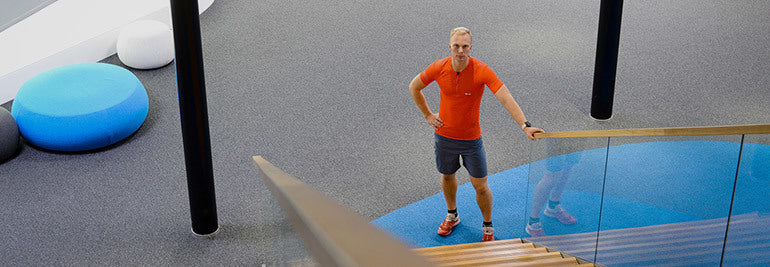
Make everything count: 7 tips for office workers to get moving
At Suunto headquarters in Finland we try to practice what we preach. Which is why we have an in-house personal trainer to motivate us all to stay fit and healthy.
Matias Anthoni, 26, roams the offices, dropping by rooms, calling on us to get up and to join him for short exercise breaks on the spot. Resistance is futile!
Matias sees stairs as an opportunity to stay active.
“My job is to maintain the health and wellbeing of everyone at Suunto,” the former footballer turned trail runner says. “Everyone who works for the company can use me free of charge. I offer group exercise classes, personal sessions, nutritional advice, and random exercise breaks. Everyone understands it’s a great opportunity.”
Matias has a Bachelor in Sports and Health Promotion, and believes there are many opportunities throughout the day for office workers to take care of their bodies and minds. Here are his tips:
1. Everything counts
Remember this phrase and make it your mantra. It cuts through all the excuses about not having time. Sometimes we get stuck in an “all or nothing” mindset; if we can’t, for example, go for an hour long run or a full gym workout, we don’t do anything at all, failing to see the possibilities that are often right in front of our faces, and don’t take much time. Matias says it’s about thinking laterally, and making everything count.
2. Three x three minutes
Take three, three-minute exercise breaks a day. Set a timer on your phone, and do it. Invite your colleagues to join you. To get you started, here’s a short video of Matias demonstrating a few simple movements – try them! “Getting the blood flowing is good for the brain,” Matias says.
3. Go out of your way
When you need to go to the bathroom or get water or coffee, rather than going to the closest option, get in some extra movement and take an extra flight of stairs to do what you need on a floor above or below. Go out of your way for the sake of a little extra movement. It all counts.
4. Have walking meetings
When you have a simple catch up meeting that doesn’t require technology, why not make it a walk and talk? Aside from the movement, people are generally less distracted and more engaged at a walking meeting. You’ll breathe better, and will feel more energized.
5. Use your lunch breaks wisely
Have a 25 or 30-minute workout before you have lunch and you’ll have more energy for the rest of your day. It could even be 15 minutes. Remember, everything counts. Do what you can, rather than getting stuck in what you can’t. “Studies show a small amount of exercise goes a long way,” Matias says.
6. Create team challenges
Try to create a culture where you encourage one another to stay active. Create a challenge to see which department or team can do the most pull-ups in a month, or can walk the most steps in a month.
7. Plan your day
When you plan your day in advance you will know when you have windows for exercise or movement breaks. Planning means you are more likely to take advantage of these. Lock them in, and make them count.
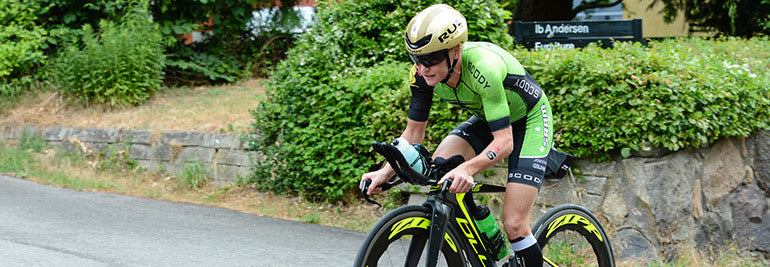
Elite runner to pro triathlete: how to make the transition
Melissa Hauschildt started running cross country and track and field when she was 11, earning her a place on the Australian team when she was only 15. At the 2006 Commonwealth games she came second in the 3000 m steeplechase.
Her promising running career took a hit in 2010 when an injury forced her to skip the Commonwealth Games. Denied her sport, she quickly improvised and got herself a bike.
“My original goal was to keep fit because I could not run at that time, but I fell in love with cycling,” Hauschildt says. “I was actually thinking of moving to cycling, but I still liked running as well. In triathlon I could do both!”
Cycling came quite naturally to her.
“I jumped on the bike, joined a cycling club and started riding with all the guys. I was keeping up with them.”
Transitioning to triathlon turned out to be the right decision; that year she came second at the Ironman 70.3 Asia Pacific Championships, in Phuket Thailand, and the following year won every race she entered.
We recently caught up with Hauschildt and asked her a few questions about the transition to triathlon.
Mel Hauschildt on her way to winning the Ironman 70.3 European Championship title in Denmark in June 2018.
Is running still your strongest discipline?
“I tend to think I am a stronger cyclist than I am a runner because I base my running on what I did when I was a runner. But in comparison to other triathletes I guess it’s still in running where I make the biggest gains on them.”
Do you have some advice to runners who start cycling?
“It seems that my running transferred across to the bike. I know that is not the case for all people. Some runners can’t ride at all.”
“One thing I did very early in my triathlon career is that I rode a lot and really backed off the running because I had running injuries. Getting all that base on the bike helped my running as well: there’s a lot less injury chance on the bike.”
A big challenge in triathlon is running well off the bike. How have you approached that?
“Practice it in training! The first time I ran after the bike, and only for half an hour, I was like, ‘I cannot do this!’” My legs were heavy and I was fatigued. But the more you do it, you just get used to running with heavy, fatigued legs and it starts to feel normal and you get better at it.
“You don’t need to do a race-like transition. Your legs will still be fatigued for quite a while. I just put my bike away, some running shoes on and go.
“I do three brick sessions a week and run off the bike. That really helps. Sometimes I get out the door and bolt off like it is a race. Other times I’ll just jog out and it’s just time on my legs off the bike.”
Hauschildt’s husband and coach Jared Hauschildt gives his advice: “We practice each different stimulus: a long bike and a short run, but also a long run off a short bike so you get used to running a long time off the bike. The third one is usually a hard bike followed by a hard run.”
Mel says that she has played quite a bit with her position on the bike recently.
Do you have some bike set up tips that makes running easier after the bike?
Jared: “There are so many different schools of thought, but generally if you go too far forward your quads get drilled and if you go too far back your hamstrings cramp on the run,”Jared explains. “Everyone is so different. Some people can adapt to really aerodynamic positions and still be fine, others will feel terrible and even on the bike they can’t push and breathe properly because they are all cramped up.
Melissa: “I think comfort is the most important. Aerodynamics plays a part, but if you are not comfortable you are not gonna ride fast, and if you are too cramped you are not going to run well.”
Do you ride on the road bike too or mostly on your tri bike?
Melissa: “I ride a lot on my road bike, probably four to five times a week. “Only the specific time trial sessions I do on my triathlon bike.
“I did some bike racing before I switched to triathlon. It’s fun, but such a different sport. It’s so tactical. The fastest person doesn’t always win and that’s what turned me away from going to cycling. I want an individual sport where the strongest person wins!”
Comfort is the key in bike set up, says Mel Hauschildt.
Are there some specific workouts you’d suggest for runners?
Jared: “We like to touch all bases with hill reps, fast riding, long riding, tempo riding, and spiking watts during a group ride. None of them are more important than the other because you really need to get endurance and you really need speed and you need the power.
“We do five minute efforts that are way above 70.3 power to get used to going really hard. Then we do 20 or 30 minute efforts at 70.3 pace.”
Melissa: “Then we do long slow rides that are all about getting the miles in the legs.”
What’s the goal with those above race-pace efforts?
Jared: “You can get to exhaustion quicker. If you want to practice the last 30 minutes of a 70.3 bike you can drill the legs with a few five-minute reps and be absolutely spent and think you have nothing left and then do a 20 minute time trial effort at race pace. In Ironman training you can do some big hill reps and destroy your legs and then ride 40 minutes at Ironman pace.”
“The high intensity quickly takes you to the point where you think you can’t ride another 10 minutes, rather having to reach that by riding 180 km every time.”
“The same principle reduces injury risk in running: if you go out and run six 1 km reps really fast and then run at Ironman pace for 20 minutes you will all of a sudden be at that point where you are completely fatigued like at the end of a marathon. But you didn’t have to do 20 km at race pace and risk injury to get there.”
READ ALSO
8 ESSENTIAL RUNNING FORM DRILLS
MEET MEL HAUSCHILDT, ONE THE WORLD'S BEST TRIATHLETES

5 life lessons learned from running the Great Himalayan Trail
© Dean Leslie / Red Bull Content Pool
The Ultra Trail Mont Blanc (UTMB), considered the world’s premiere ultra race, has haunted 36-year-old South African athlete Ryan Sandes since 2015.
The last three times he attempted it, “trail karma” got the better of him: first glandular fever knocked him out, the second time he dropped out after 40 km due to a stomach infection, and in 2017 he finished in the top 20, but only after soldiering through the race with dead legs.
Now he’s in Europe training in the Alps to give it another shot in late August, and this time something has changed – his attitude. For the build up to UTMB, Sandes ran the Stubai Ultra – 63 km, 5075 m ascent. Unfortunately, he had pull out of the race early. “That didn’t go according to plan,” he said on Instagram. “It seems my climbing legs are still in the Himalayas. I was pretty disappointed to cut my race short.”
© Dean Leslie / Red Bull Content Pool
In spite of this, and his previous bad luck on the UTMB, Sandes is feeling unusually relaxed. He puts it down to some of the hard lessons he learned while smashing the Fastest Known Time (FKT) on the Great Himalayan Trail with Ryno Griesel in March this year.
“In the past I put too much pressure on myself at the UTMB with time and results,” Sandes says. “Now I just want to enjoy the process.
“I want to do the best I can, but there’s only so much you can do. You can’t get too freaked out. I don’t want to look back 10 years from now, and say, ‘yeah, I ran UTMB, but I hated most of it because I was too fixated on the result.
“I want to enjoy the overall experience. The end goal is just a byproduct.”
Here are Sandes’s life five lessons from the Great Himalayan Trail:
© Dean Leslie / Red Bull Content Pool
1. Break things down into bite size chunks
“For ultras, it might be from one aid station to the next,” Sandes says. “For normal life projects, like building a house, find a similar way to try to wrap your head around it. Sometimes I think too far ahead, and then I get stressed. On the Great Himalayan Trail I was forced to take it day by day – it was too big to do otherwise. It was cool learning to be really present and in the moment.”
2. Be generous
“The Nepalese people are incredible, how welcoming and supportive they are. It taught me one small thing you do can make a big difference in a person’s life. It’s all about being thoughtful. Nepalese in the mountains live a basic life, but they are super family orientated and friendly. It was quite a big reminder for me, especially now I have baby boy. In the west, everything is so quick and busy, that we sometimes forget to prioritise family. It reminds me to keep things simple.”
3. Focus on the small things in life
“In modern society we have massive goals, it’s shoot for the moon, which is important, but it’s also about being content with the smaller things in life. I get so hell bent on a race, I neglect family and the small things in life. We can become so driven sometimes that life can feel empty. It’s about balance, and appreciating small pleasures.”
4. Don’t overthink it
“I learned I’m a little bit of a control freak. It taught me there are so many things I can’t control. With life in general, it’s the person who can think on his feet who does the best. You need to be responsive to what life throws at you. In the Himalayas, we had quite a detailed plan in place, but everyday everything went out the window. It was pretty cool. Don’t overthink and freak out – you won’t enjoy yourself.”
5. Focus on the positive
“In the Himalayas, I had a two day period when I was really missing home. Interestingly, that was the toughest time for me physically. The physical follows the mental. To counteract this I told myself that it was a one off opportunity, it was my decision to be there, and lots of people dreamed of doing what I was doing. I also focused on the scenery and interacting with the locals. That definitely improved things.”
Lead image credit: © Dean Leslie / Red Bull Content Pool
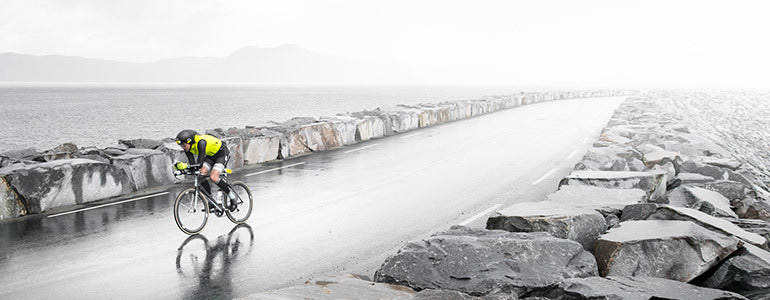
Testing human physiology at the Norseman Xtreme Triathlon
© Kyle Meyr/nxtri.com
Ask Jonny Hisdal about the 226 km Isklar Norseman Xtreme Triathlon and you’ll get the honest truth. He should know afterall – not only has he completed the race course 12 times, as a physiologist he’s also researching what it does to the human body.
“Most of your biomarkers (chemicals, molecules, and hormones present in the blood indicating different forms of illness) are sky high when you reach the finish line,” he says. “If a doctor tested your blood immediately afterwards it would look like you are really sick, or having heart and kidney failure.”
© Kyle Meyr/nxtri.com
The good news is this alarming biomarker profile only lasts a short time. A day after the race the biomarkers are already on the way back down. Whereas, if you were really sick, the biomarkers would remain at the same level.
Hisdal is currently preparing to sample the blood of more than 40 finishers immediately after the end of the race, which starts on August 4. The goal is to understand what the normal blood levels are after such an extreme race. He’s also participated in a study looking at the possibilities and limitations of cold water swimming – the race includes a 3.8 km swim in a fjord with water temperature ranging between 13 and 15.5 °C.
To reach the finish line of the Norseman demands more than endurance fitness. “Yes, it requires really good base fitness, and a high level of endurance,” Hisdal says, “but also a lot of mental strength to compete for so many hours. The average athlete needs about fourteen fifteen hours.”
© Kyle Meyr/nxtri.com
Hisdal is also on the safety team for the race, and recently completed the course along with the rest of the crew, making it his 12th time. He first competed in the race as an athlete in 2005, and did so the following five years. Since then, he has been on the race organising team.
“The swimming is the easiest part, something that everyone should be able to do,” he says. “Average athletes are in the water for one and a half hours – that’s a long time if you are not used to it.”
“After that you jump on the bike and cycle for 180 km, including 3000 m elevation gain. If you are not used to cycling uphill it's impossible to do it. Then you are running 25 km on the flat, and the remaining 20 km uphill for 2000 m of ascent. It's brutal.”
© Kyle Meyr/nxtri.com
Some people, he says, quit before the race has even started. Others pull out 1000 m into the swim, and some on the bike during the climb. But the majority make the finish line, after giving their blood, sweat and tears to the terrain. “The biggest problem is people train too much so they get injured,” he says. “Almost everyone overtrains.”
Click here to see Suunto's range of triathlon watches!
The race has played a central role in popularising triathlon in Norway. Before it began in 2003, triathletes were hard to find in the country, whereas since the inaugural race triathlon clubs have been growing in membership. Only about 20 athletes signed up for the first race in 2003. Now, 4000 people from all over the world apply, vying for only 280 start positions.
“The reason why I do it is because it's an incredible experience, and it keeps me motivated to train and stay in shape,” Hisdal says. “It's not really like a normal competition; it's more like adventure or travelling. It's travelling through breathtaking geography, and also mentally; you travel through really deep lows and up to some really big highs.”
© Kyle Meyr/nxtri.com
Here are Hisdal’s five tips for the Isklar Norseman Xtreme Triathlon:
1. Train uphill
“It's essential to train uphill, both bike and running, because the race includes 5000 m of it.”
2. Get used to cold water
“It’s a necessity to train your swimming in cold water. It should not be the first time when you start the race because it will give you problems.”
3. Train longer sessions
“It’s important to have some long training sessions of at least six or seven hours so you know what you will experience during the race.”
4. Know your fuel
“You need to be able to eat and drink for the race length. What you should eat, when and how much, is something you need to practice well in advance. It's very individual. You need to learn what your body can tolerate.”
5. Race smart with a sports watch
“Learn to control your intensity with a sports watch like the new Suunto 9. The most important thing is not to start too hard. If you are too high in intensity in the first few hours you will suffer for the rest of the race.
“I have used sport watches and a heart rate monitor to make sure I'm not too high in intensity. I have a max heart rate I can tolerate, and if I reach that I slow down a little. It's very easy to be too eager in the beginning, when people are passing you. You are blinded by adrenaline at the start and cannot trust your feelings. You will feel very strong, but suddenly the hammer comes down and you're finished. Sport watches help manage this – just make sure your one has enough battery life.”







































